The Collard & Collard piano factory
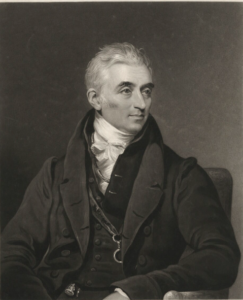
The piano company by Collard & Collard was one of the most successful piano manufacturers in England in the 19th century and was founded in 1832 by the two brothers Frederick William and William Frederick Collard. Both had previously been in partnership with the composer and piano maker Muzio Clementi (1752-1832) and other partners.
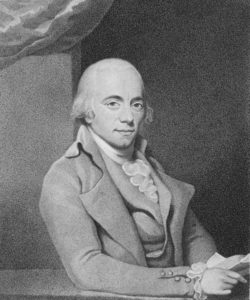
Muzio Clementi (1752 – 1832) by Thomas Hardy in 1794
The surname Collard can be traced back to the 13th century. The spelling at that time still followed the Anglo-Saxon spelling of Colleart. In origin, the name derives from the first name Nicholas (Nicholas). A common diminutive of the name Nicholas was Col. The suffix “ard” was a Norman-French suffix meaning “son of“. (see.: P.H. Reaney, R.M. Wilson, A Dictionary of English Surnames. London: Routledge, 1991)
Another source notes that the name may have been derived “from the Anglo-Saxon col, [meaning] a helmet, and hard to hear“. (see: Lower, Mark Anthony, Patronymicy Britannica, A Dictionary of Family Names in the United Kingdom. London: John Russel Smith, 1860)
Colleart has been written in many different ways over the time. Before English spelling became standardized over the last hundred years, different spellings of names were common. As the English language changed during the Middle Ages, absorbing parts of Latin and French as well as other languages, the spelling of people’s names also changed significantly. There were many different spellings of the name Colleart, including Callard, Collard, Collarde, Colard, Colarde, Cullard, Collart, Collerd and many more versions.

Frederick William Collard by Charles Turner, after James Lonsdale – National Portrait Gallery London
Frederick William Collard was the son of William and Thamosin Collard along with his brother. He was born at Wiveliscombe, Somerset 1772 and baptized 21th June 1772. He went to London at the age of 14 and got an employment at Longman & Broderip. In 1795 Longman & Broderip ran into commercial difficulties and a new company was formed consisting of J. Longman, Muzio Clementi, Frederick Augustus Hyde, Frederick William Collard, Josiah Banger and David Davis. From 1798 instruments were then sold under the names Longman, Clementi & Company. On 28th June 1800, Longman and Hyde went out of business and Clementi, after Longman went to prison again, began making instruments under his own name. James Longman died in prison in November 1803.
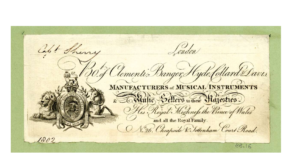
Trade Card – Muzio Clementi 1802, © The Trustees of the British Museum
Muzio Clementi worked closely with his partner Frederick William Collard, as evidenced by letters Clementi wrote to him during his extensive travels. He commissioned F. W. Collard several times to select suitable instruments for selected customers. He also received authorization from Clementi to send Beethoven a payment for the publication rights of certain works.
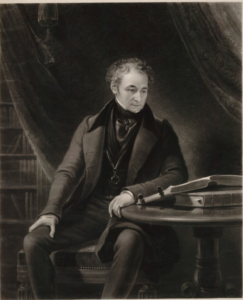
William Frederick Collard by Thomas Goff Lupton, after James Lonsdale – National Portrait Gallery London
William Frederick Collard, the younger brother was also born in Wiveliscombe and baptized 25th August 1776. In addition to a talent as piano maker and inventor, he also had a penchant for poetry and literature. He became a partner in the company in 1810. In 1811 F. W. Collard received an English Patent (No. 3481) for an improvement on upright pianos. (see: Rosamond Harding, The Pianoforte ― its history traced to the Great Industrial Exhibition, 1851)
On 24th June 1817, Josiah Banger left the company. In 1821, F. W. Collard filed Patent No. 4542 for a harmonic swell consisting of an additional bridge and a block of wood that could be moved up or down to control the sympathetic vibrations of the strings. Clementi called this new invention of changing the tone “Harmonic Swell and Bridge of Reverberation.” However, this patent did not originate with F. W. Collard. Clementi had first seen this type of tone change years earlier in Switzerland. The Swiss Christian Müller from Bern, who used exactly the same system as early as 1784, can be regarded as the inventor. A square piano with this system is also part of the Eric Feller Collection. Click here for more information about the instrument – Christian Müller, Bern 1784.
The partnership between F.W. Collard, W.F. Collard and Clementi expired on June 24, 1831. After Clementi’s death on March 10, 1832, both brothers took over the company and instruments were manufactured under the name “Collard & Collard“. Due to the very high reputation that Clementi’s instruments had, the two brothers continued to use his name on their instruments to intensify the business and not suffer any losses after Clementi’s death. The addition “Late Clementi, Collard & Collard” was also found under the company name. The two Schoene brothers already used a similar form of marketing: In the late 18th century they still advertised with their former business partner Johannes Zumpe. You can find an example of their instruments here – Square Piano by Schoene & Co. 1788 – Eric Feller Collection.
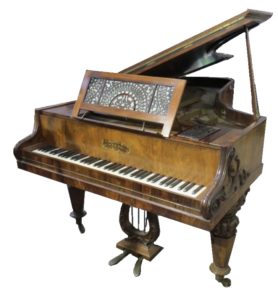
Fortepiano by Collard & Collard, London ca. 1843 – Eric Feller Collection
The two brothers carried on the business until June 24, 1842, when W. F. Collard retired. F. W. Collard, then acting as a sole proprietor, took his two nephews, William Collard jun. and Charles Lukey Collard in partnership. On December 10, 1851 the factory in the Oval Road in Camden Town was completely destroyed but rebuilt. In the course of the company’s history, many patents have been applied for to improve both the action and the construction of the instruments. The company gave up the music publishing business in 1834 and limited itself to the manufacture of pianos. The publishing business was sold to Zenas Trivett Purday. In 1858 Collard & Collard was commissioned to supply horns, fifes and drums to the regiments of the East India Company. The company had long been based on Tottenham Court Road.
W. Collard died at Cheapside on January 31, 1860, aged 88. He has lived permanently in the same house since arriving in London. His brother W. F. Collard died in Folkestone on October 11, 1866. The company continued to produce instruments. The circular factory building at Oval Road in Camden Town was defining for the company. The workbenches stood in front of 22 high windows and in the middle of the round building was an elevator connected the floors with each other. This construction method generated minimal costs for building material while maximizing light within the factory.
There was a small boom in the piano industry immediately after World War I, but this was soon marred by the rise of the gramophone, cinema and radio. The company sold the building in Oval Road in Camden Town in the 1920s and their round factory was occupied by various companies over the years. In 1929 the firm was sold to the Chappell Piano Company of London and the Collard & Collard name continued until around 1960. Unfortunately, a fire in 1963 destroyed all of Collard and Clementi’s documents, which became the property of Chappell Pianos when the company took over in 1929.
© Eric Feller – Early Keyboard Collection – March 2022

